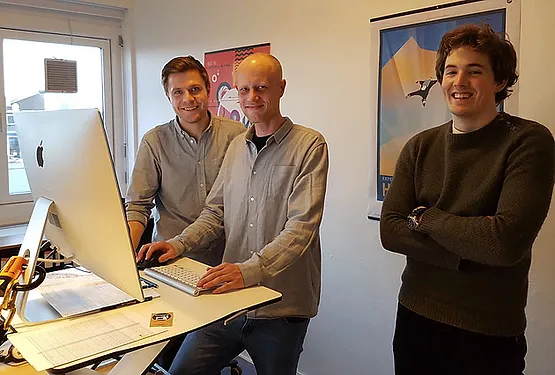After months of preparation the day finally arrived: It was time to push the button and set our Kickstarter-campaign into motion. Prepared with high spirits and chilled beer we gathered at the office, launched the campaign, pushed the message to our network. And then nothing. A big anti climax where we just starred at the screen, hoping for the first pledge.
The content for the campaign was ready and we had done our best to build a network around Opløft in the sparse time we had before the launch. The last important consideration: when should we launch the campaign?
We decided Wednesday 20. April was a good day, chose to launch in the american afternoon (we thought our main market would be USA) which made it evening in our local time, when we launched.
Twenty minutes (and some, tense “people don’t like us”-jokes) after the launch, the first backer made a pledge. And with our considerations in mind, we got a little surprised to see it coming from a backer in Asia.

The launch obviously had to be done from the Opløft-prototype!
Outreach: Focus on the Middle
After the initial anti climax the pledges thankfully started coming, and after 15 hours we had reached 15% of the project goal. From there sales started slowing down – as expected – which can be really tough to see, when you check the campaign every half hour hoping for new backers.

Distribution of pledges per day throughout our campaign. Graphic: Kicktraq.com.
For most campaigns – including our – pledges peak in the beginning and in the end. In the beginning you get a lot of traffic from Kickstarter, someone in your network has hopefully been waiting to back the project as soon as it’s online and it has some newsworthiness that makes it easier to sell your story. In the end those who have been considering buying it all along has to decide and the “this deal is soon over”-effect kicks in.
This means, you should focus on the middle. The middle is where it gets tough and you really have to struggle for every backer.
Obviously there’s a ton of ways to get traffic to the campaign in “the middle”. We made some spontaneous decisions and grabbed the opportunities we got during the campaign, but those we planned and used strategically proved most effective:
Social Media:
Both posting relevant updates and content around Opløft on our owned channels and paying for advertising which led potential new backers to our Kickstarter-page.
Press:
Earned press is really effective. The days we were featured on Fast Company and Yanko Design was some of the days we sold the most – but it’s not necessarily easy to get featured. Instead of taking the easy and less elegant way of just buying a mailing list and spam it, we spend the months prior to our launch doing research for relevant outlets and journalists. We started pitching the product-story one week before the launch (in hindsight we could have done it way earlier) and kept pitching different angles that would be relevant to the individual outlets audience: product details, health issues surrounding sedentary work, the design process and so on.
Cross-promotion with other kickstarter-projects:
We promote you if you promote us. We sat up deals with a good handful of other Kickstarter-projects we liked. It wasn’t terribly effective, but it was free – and we might have helped someone else as well, so why not?
Be Prepared For The Tsunami of Messages
While we spend a lot of time on outreach, we knew we had to be prepared to answer questions and handle suggestions and ideas from backers as well. We just weren’t prepared for the tsunami that would hit us:
SEO optimization, marketing-deals, referal-programmes, PR-offers, mailing lists, influencers who wanted a free Opløft. Basically a ton of people who wanted to help us succeed in exchange for a slice of the money, we were trying to raise.
We rejected most offers, and those we ended up paying for wasn’t worth the time and money. The many, many enquiries you will get might work for some, but don’t buy the services out of panic.
On a more positive note, there was also some interesting messages among all the offers for Kickstarter help – especially from distributors from around the globe, who wanted to be involved in selling Opløft when the Kickstarter was done. But before signing any deals we got this email one week before the campaign ended:

During the following week that email ended up changing our plan for Opløft – but more on that in the next post.
About the series: We knew very little about crowdfunding, when we decided to crowdfund our height-adjustable desk OPLØFT in the beginning of 2016. The experience was intense, but in the end we got the $60.000 we needed to start production. The journey has taught us a great deal, and in this series we want to share our insights, do’s and don’ts, so you can learn from our mistakes. This was part 4 of our Crowdfunding Tips. You can find the rest of the series here: #1: Should we crowdfund this? #2: What should my campaign video look like?
